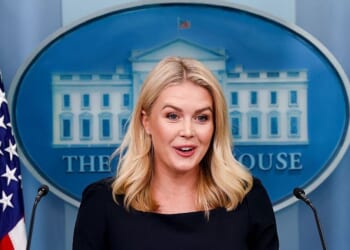Moving forward with the Biden administration’s guidance could deliver lower drug prices and allow more Americans to reap the benefits of public science.
In late 2023, the federal government published a draft guidance document that clarified a key provision of the Bayh-Dole Act, which governs the ownership of inventions created by government-funded research. The framework, while esoteric, held enormous promise, with the potential to drive down drug prices, galvanize innovation, and allow more people to reap the rewards of public science.
However, after more than a year of sitting in limbo and a change in presidential administrations, the fate of the framework is uncertain. President Trump seems poised to do away with the guidance, a decision that could lock the American people into a future of high drug costs and reduced access to the technologies developed with their tax dollars.
Background
The Bayh-Dole Act, officially the Patent and Trademark Act Amendments of 1980, changed the way federal agencies managed the intellectual property produced by federally funded research. Before the law, government-funded IP belonged to the agency that funded the research, which could then license patents to companies, entrepreneurs, and other groups however it saw fit. Under Bayh-Dole, however, this IP was awarded to the groups that conducted the research, like universities or federal contractors. This seemingly small policy change had major ramifications, granting non-government actors the exclusive right to commercialize—and profit from—their government-funded discoveries.
The Bayh-Dole Act was intended to make the federal R&D ecosystem more efficient. Its supporters argued that policymakers could help bring more technologies to market by increasing contractors’ financial incentives to commercialize their work and freeing them from the government’s ostensibly restrictive licensing procedures.
But while many celebrated the law, others believed that taxpayer-funded inventions should remain under public purview rather than under the exclusive control of a private company, which would have the power to limit access to potentially life-saving technology in the interest of profit. To placate critics, Congress added a provision to the law that allowed the government to reassert control over these patents in scenarios where the patent holder was not making the invention sufficiently accessible to the public. Public health and safety needs were specifically emphasized as factors making accessibility crucial. These “march-in rights” were meant to act as a check, ensuring universities and companies made their innovations available to the public on reasonable terms, but the government has never exercised these march-in rights in the law’s 45-year history. In that time, Bayh-Dole has seemingly become a pillar of the U.S. innovation ecosystem.
Recently, however, rising costs of pharmaceutical drugs have reignited old debates about the pros and cons of privatizing public science.
The pharmaceutical industry has benefited significantly from the Bayh-Dole Act, as the final recipient of many of the publicly-funded patents. In recent years, critics of Big Pharma have argued that charging exorbitant prices for these taxpayer-subsidized drugs violates the Bayh-Dole Act, and by “marching in” on these patents, policymakers could help lower prices and increase access to life-saving medicines. The pharmaceutical industry has pushed back vociferously, arguing that government funds cover only a small share of drug development costs. By threatening to “march in,” policymakers would disincentivize companies from participating in government research and reduce healthcare innovation.
Eventually, the Biden administration weighed in on this debate between public accessibility and innovation incentives.
The NIST Guidance
In December 2023, the National Institute of Standards and Technology (NIST) released a draft guidance document that aimed to clarify when federal agencies could exercise their march-in rights and the factors they could consider when making such determinations. Most of the guidance discussed the tradeoffs between promoting innovation through patent protection and ensuring public access to that innovation through march-in rights. However, it also explicitly stated that under existing law, policymakers could consider a product’s price when determining whether to march in, opening the door to the sort of interventions advocated by Big Pharma’s critics.
Public reaction to the NIST guidance was visceral, with views divided down familiar political lines. Senator Elizabeth Warren praised the new framework as part of a “righteous fight” against corporate greed, while the Wall Street Journal called it the White House’s “most economically destructive executive act to date,” accusing the Biden administration of “rewriting laws to arrogate sweeping power.”
NIST was inundated with nearly 52,000 comments from both supporters and critics of the draft guidance. After the comment period closed in February 2024, the measure fell out of the public eye. No final version was released, and the draft was seemingly in limbo when Donald Trump reentered the White House.
The Trump administration has not made any statements about the guidance on march-in rights, but signs point to the new president doing away with Biden’s attempted reforms. During his first administration, Trump unsuccessfully attempted to push through a new rule that would explicitly prohibit agencies from exercising march-in rights based on consumer prices, which would have settled the issue in the pharmaceutical industry’s favor. Robert F. Kennedy Jr., the newly confirmed Secretary of Health and Human Services, has said he is open to exercising march-in rights, though he has rejected the idea price should factor into those decisions. As such, it seems likely that President Trump could enact a similar policy to his first term, or at least let Biden’s attempted reforms wither on the vine.
Allowing the NIST framework to languish would not only deal a victory to the pharmaceutical industry at the expense of the public, but it would also undermine the very spirit of government-funded research and the Bayh-Dole Act itself.
Pricing March-In Decisions
To assess the advantages of NIST’s march-in framework—and specifically its assertion that consumer prices should factor into march-in decisions—it helps to understand the arguments made by its opponents. Typically, this criticism revolves around three factors: legal legitimacy, financial fairness, and innovation incentives.
Some opponents of the framework argue that because the Bayh-Dole Act does not explicitly discuss price as a relevant factor for march-in decisions, any consideration of product costs constitutes executive branch overreach. Years after its passage, the law’s authors—who by then were working as pharmaceutical lobbyists—penned an op-ed that argued this position.
Other opponents assert that price considerations are particularly unjust in pharmaceutical development, since private companies spend significantly more money bringing drugs to market than they receive from the federal government, and drugs are often based on multiple patents, some of which are not government-funded.
Finally, critics also argue that making march-in decisions based on price could chill healthcare innovation by disincentivizing researchers from accepting federal funding. If drug developers fear they may not recoup their investments in a new drug due to government march-in, they might decide to exclusively develop drug candidates in-house, leaving promising university pharmaceutical patents sitting unused and making it harder for startups interested in those patents to attract investment.
Aspects of all three arguments are misguided, if not outright wrong. First, omitting price from the text of the Bayh-Dole Act does not explicitly prohibit its consideration. While the law defines where march-in rights can be exercised, it does not explicitly state any of the specific factors that agencies can or cannot consider when making such determinations. Second, the relative investments of public and private actors are somewhat irrelevant when it comes to exercising march-in rights. Any patent developed under Bayh-Dole is subject to march-in rights, regardless of commercialization costs.
Opponents’ concerns about disincentivizing innovation are valid, but discount the benefits that businesses receive from federal research. Innovation is an inherently risky process, with the vast majority of research endeavors failing to yield any commercially viable projects. Government research funding significantly de-risks this process, subsidizing failed projects while allowing researchers—and any private companies that ultimately gain control of their patents—to capitalize on successful endeavors.
The NIST draft guidance is quite deferential to its opponents’ concerns urging agencies to “ensure that any use of march-in achieves the intended outcomes and does not have broad and unintended consequences on U.S. competitiveness and innovation.” It calls on policymakers to consider how important federally funded patents are to a particular invention, in comparison to other non-Bayh-Dole patents involved. Furthermore, the guidance states that “march-in considerations are extremely fact-dependent,” and that “any decision to exercise march-in will be made based on the totality of all circumstances.”
In other words, the NIST guidance does not bully agencies into using their march-in rights—rather, it lays out a framework for ensuring march-in rights are not abused in a way that causes harm.
Public Science for the People
At the core of the controversy over the NIST guidance is a much broader question, one that dates to the origin of the Bayh-Dole Act itself: how can policymakers ensure that public science delivers the most public good?
As the Bayh-Dole Act makes clear—and the NIST framework reiterates—there is no one-size-fits-all answer. Privatizing government-funded patents and protecting that IP can incentivize innovation that improves the lives of the American people, but it can also open the door for those firms to charge excessive prices that limit the public’s access to the inventions their tax dollars helped create. Openly licensing patents may hurt the bottom lines of the companies that pioneered those discoveries, but it can also drive down prices and galvanize innovation by allowing companies to iterate on those ideas. The Bayh-Dole Act relies on market incentives as the default, but it also recognizes these other contingencies and provides policymakers with a tool (march-in rights) that they could use to maintain the balance between incentivizing innovation and promoting public access.
When it comes to reconciling the legislation’s often-conflicting goals related to private sector and public interests, few factors are more relevant than price. The cost of a particular technology—a life-saving drug, an ultra-effective water purifier, or a novel sensor for preventing traffic accidents—is one of the most important determinants of that technology’s accessibility. The more expensive something becomes, the fewer people can afford it, and the further it drifts out of reach.
Excluding price from march-in considerations would give private companies near-total control over the terms on which the American people can benefit from the inventions their tax dollars helped create. As profit-maximizing entities, firms will wield that power in ways that most benefit their bottom line, and not always in ways that align with the public good. While profit motives can drive beneficial innovation, they can also incentivize price gouging and other socially harmful conduct if left unchecked. Even if they are not exercised, the government’s march-in rights deter companies from unfairly exploiting the fruits of public science for their benefit.
Some have argued that pharmaceutical companies need to charge exorbitant prices to subsidize their investments in drug development. However, it seems unlikely that modestly reducing their profit margins—whether through government-imposed patent licensing or voluntary efforts to avoid such a march-in situation—would pose an existential threat to their business. Consider the fact that between 2021 and 2023, the five largest U.S. pharmaceutical companies (Johnson & Johnson, Merck, Pfizer, Abbvie, and Bristol Myers Squibb) collectively spent almost as much on dividends and stock buybacks ($169 billion) as they did on research and development ($182 billion). These are not cash-strapped companies, and the NIST guidance affords them ample opportunity to negotiate with policymakers to ensure that march-in rights are not used in ways that cause undue harm.
Understanding the effects of march-in decisions will certainly require an in-depth analysis of markets, supply chains, investment patterns, and other factors related to specific products in specific situations. Drug companies could help policymakers and the public better evaluate these impacts through greater transparency, such as sharing information about drug development costs, which today is generally not made public. The NIST draft guidance recognizes the complicated reality of technological innovation and seeks to add clarity and consistency to a legal authority that has remained opaque and underutilized for more than four decades.
Should Trump do away with the draft guidance and proposed reforms, he would leave the American people—including many of his supporters—less healthy, less safe, and less prosperous. Instead, he should stand firm and push NIST to release its final guidance, ensuring that American taxpayers get what they paid for.
About the Authors:
Vikram Venkatram is a Research Analyst at Georgetown University’s Center for Security and Emerging Technology (CSET).
Jack Corrigan is a Senior Research Analyst at Georgetown University’s Center for Security and Emerging Technology (CSET).
Image: Shutterstock
















